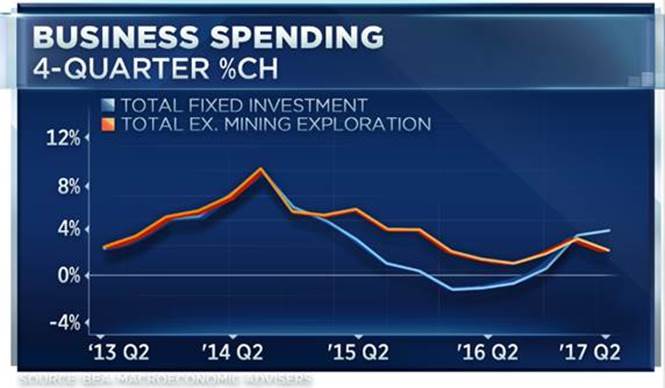Trump might be boosting economic growth but overstates his role, economists say
August 2, 20171.4K views0 comments
While most economists say President Donald Trump may be overstating his responsibility for recent better growth and jobs numbers, they say his policies may have had a limited positive influence in some areas.
At the same time, they warn, there are ways the president might also be a drag on growth.
Take the GDP number announced on Friday. “Remember I was saying we will hit 3 (percent growth) at some point in the not-too-distant future, and everybody smiled and they laughed and thought we’d be at 1. And 2.6 is an unbelievable number, announced on Friday,” the president said Monday.
Most estimates of second-quarter growth, however, were around 2.3 percent before the president’s election. Growth in the first half of 2017 is averaging 1.9 percent, about what it’s been for the past several years.
Read Also:
“It was obviously the case that the second quarter was a rebound from the first quarter,” said Bruce Kasman, chief economist for JPMorgan. “First-half growth is no better than anything happening before that.”
Economists say it’s difficult for any president to have much effect on growth in the first full quarter in office, particularly one who hasn’t passed any major economic legislation. To the contrary, the failure of health-care reform so far looks to have caused Wall Street to push back its expectations for tax reform and mark down the chance of it happening at all.
But as the market nears a record 22,000 Tuesday on the Dow Jones industrial average, those higher stock market prices and the rise in business confidence along with an end to the increase in regulations from the Obama administration could be having a positive effect.
Doug Holtz-Eakin, president of the American Action Forum (which bills itself as a “center-right think tank”), says President Trump put an end to rising regulatory costs. He pegged those costs at $890 billion over the eight years of the previous administration. Holtz-Eakin said that could help boost business confidence and, in turn, investment spending.
Spending for business equipment did rise in the second quarter, but it’s unclear how much of that was from a rebound in oil drilling that followed a rise in oil prices last winter. Excluding spending for mining exploration, Macroeconomics Advisors found that nonresidential fixed investment growth actually fell in the second quarter.

In any event, these are early days to suggest that the president’s policies have affected long-run capital spending. Continued high levels of business confidence could prompt CEOs to pull the trigger on new spending that could eventually boost productivity and growth.
The wealth effect through the stock market presents a better case for the president’s claims. The market shot up when he was elected and has continued to gain since then. A rule of thumb is that every dollar of stock gains produces five cents of additional spending. Macro Advisors suggests that’s about $130 billion of spending over the course of a year, or perhaps a quarter point to GDP over the course of a year. That positive wealth effect will continue to boost growth in the third quarter.
On the negative side, Holtz-Eakin says the president’s immigration and trade policies along with the uncertainty his chaotic administration has created could actually drag on growth.
Moody’s Analytics chief economist Mark Zandi says it’s too early to conclude either way about the Trump effect. He says the economy was “doing fine” before he took office and hasn’t changed much. He did add the president will get a chance to have a real impact in coming months. “They have got to raise the debt limit and pass a budget,” Zandi said. “If they don’t do that, it will do real damage.”
